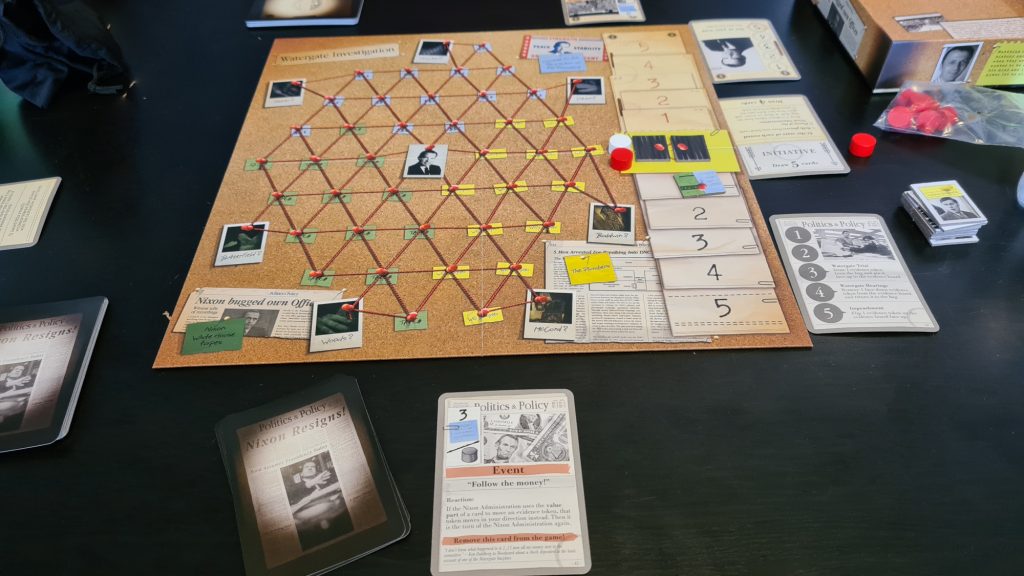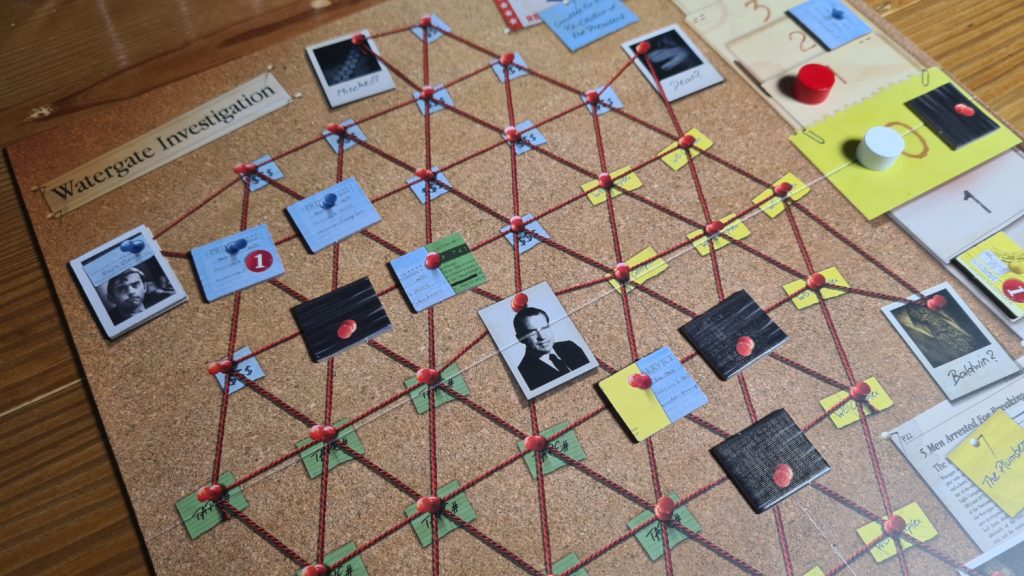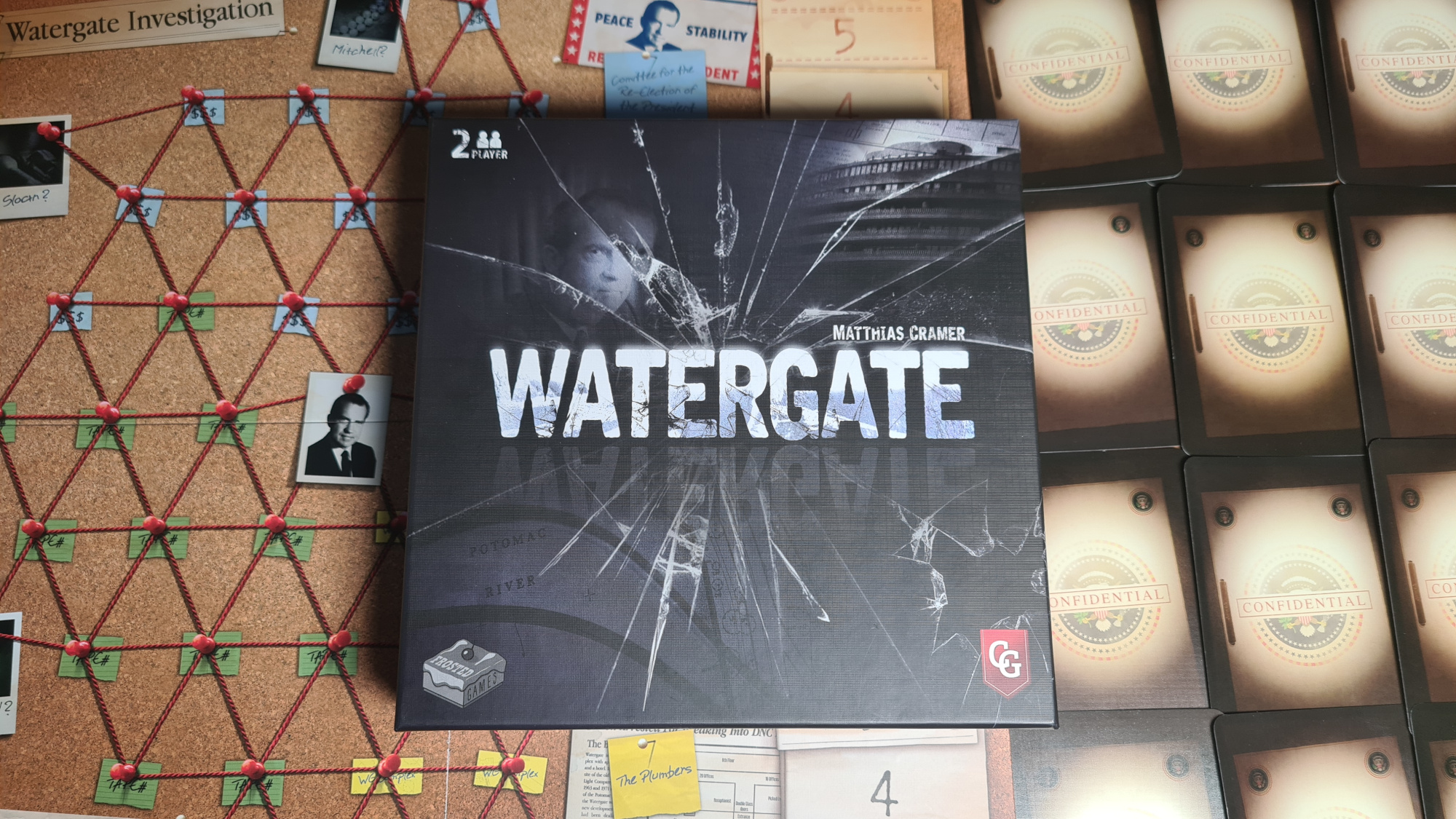Watergate isn’t just one of the largest American political scandals of all time, it is now also the theming for Frosted Games’ new tug of war style card game. Published alongside Capstone Games, designed by Matthias Cramer, the game sees 2 players take up the opposing roles of the Nixon Administration and The Washington Post. Lasting around half an hour the players will try to either connect evidence of wrongdoing to the President or simply last out the Presidential term. However, is playing the game like lasting out the experience or is it one that’ll go down in history? Let’s find out!
Starting off, the two players need to decide between themselves who will take up the role of the Nixon administration and who will be The Washington Post. With the board placed between them, each player takes and shuffles their own personal deck of cards. Both players place their momentum card to the side of the board, with the initiative card placed so it is facing the Washington Post player for the first round. All of the evidence tokens are put into the cloth bag, with the 7 picture tokens placed to one side of the board, and then the game of Watergate is ready to go.
At the start of each round players draw cards from their deck. The player with initiative draws 5 cards – whilst the other player only draws 4 cards. At this point the Nixon administration player secretly draws 3 evidence tokens from the bag, taking a look and placing them face down on zero space of the research track. A momentum token and the initiative token are also placed in the middle of the tracker.
Each turn the player will choose one of their cards to play. Each card has two parts: a value and an action. Choosing which they want to use the card for, the player will normally aim to shift the tokens on the research track towards them, though actions allow informants to be added to the central evidence board, see random evidence found and much more.

The value part of a card shows a colour of evidence and, unsurprisingly, a value. While the Washington Post player has to take somewhat of a stab in the dark, asking their opponent if a colour is on the track, once a colour evidence has been moved it is flipped face up. It is then moved towards the player by the value on the card. For the majority of the game cards will be used for their value, as most actions see the card removed from the game and not just discarded. This is important as when a player’s deck runs out they reshuffle all of their discarded cards to be able to redraw their hand of cards.
Once all cards have been played the round is over. Any neutral evidence is returned to the cloth bag, with the rest of the tokens earnt by whichever player they are towards on the track. Gaining the initiative token turns the initiative card towards you, meaning you will have the first turn and the card advantage for the next round. The momentum token is removed from the track and placed onto the round winner’s momentum card. For the Washington Post player this can unlock one time bonuses, while getting to 5 wins Nixon the game. Evidence gained is placed onto matching colour spaces on the evidence board. The Nixon administration places their tokens face down, blocking routes, whilst the Washington Post player places theirs face up – to make a route between Nixon, in the center of the board, and the informants, around the edge.
The Washington Post player wins if they manage to link Nixon via routes to two different informants, both of which need to have been placed face up onto the evidence board. If neither this nor Nixon getting to 5 momentum tokens has yet to occur then it’s onto the next round. One key aspect is that the claiming of tokens can happen mid-round, not only at the end. If a player manages to get any token, be it evidence, initiative or momentum, to the 5 space on their side of the research track it is instantly claimed – with evidence or the momentum token perhaps being enough for someone to win!
Balance is only truly going to become apparent in a game like this over a colossal number of plays. Both sides have some extremely impactful cards though. Be that the ability to move a token a huge amount on the tracker or a unique ability. Nixon can end a round prematurely, whilst the press can obtain random evidence or get a potential witness back even after Nixon thinks they have secured their silence. Some of these abilities feel insanely strong, but the fact both players have access to these unique and strong powers doesn’t make them overpowered.

Timing is still key to using the actions to their utmost effect. Using the right power at the wrong time could give your opponent enough time to counteract it, whilst holding onto a strong card might see an ability triggered that renders it useless. Combine this with most strong abilities seeing the card discarded and the choices of when to use powers and when not to becomes full of mind games, both with your opponent and yourself.
While the two sides of the Watergate scandal play somewhat differently, and have differing win objectives, the game is still easy to learn. A lot of the game is impacting the tokens on the research track. Why each player is attempting to manipulate tokens on that track may differ. Yet, they are still trying to secure as many of the tokens as possible each round, simply because it makes their life easier. As the game is more a tug of war than a cat and mouse scenario, despite the press going after Nixon, the whole experience doesn’t change when shifting from one side to the other between games. Still, it’s possible to be more partial to one of the sides, with the small differences such as the fewer bits of hidden information for the Nixon player.
Watergate is a heavily themed abstract style experience. All the cards, the events and people depicted on them, have historical details in the rulebook of their real world importance. There is clearly the intriguing political theme there that makes a lot of the actions carry more weight than they almost deserve. This is from the viewpoint of someone interested in history and that event. Looking past the theme though players are pulling tokens to their side of a tracker and placing them on a network like board, which just happens to visually look like a classic evidence board. There is no doubt that the theme adds to the experience but regardless there are interesting choices and opportunities for strategy that should keep all players immersed – unless someone really detests the political theming.
Watergate boils down to a tug of war. The twists that make it exciting, tense and make every turn count all revolve around there being multiple elements that you want to “pull” simultaneously. At no point do you want your opponent to get their hands on any of the tokens. Either they get momentum to help them, an advantage in the subsequent round or simply get evidence to pin on the board. For those that have no interest in the theme, there is still a solid game underneath. However, Watergate will shine for those that like the idea of manipulating the tug of war and the theme, as they work incredibly well together.
(Editor’s Note: Watergate was provided to us by Asmodee for the review. The game is currently available from local board game stores! Find your local store here.)

